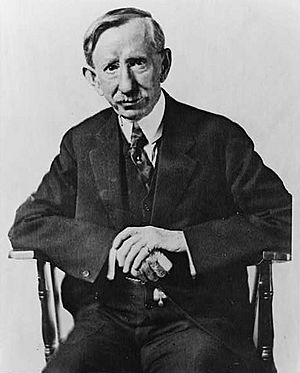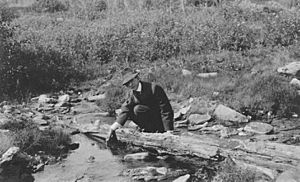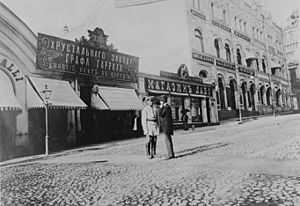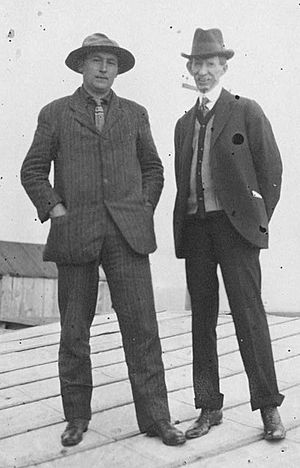Frank G. Carpenter facts for kids
Quick facts for kids
Frank G. Carpenter
|
|
|---|---|

Frank George Carpenter
|
|
| Born | May 8, 1855 |
| Died | June 18, 1924 (aged 69) |
| Occupation | Author, geographer, photographer, lecturer, collector of photographs |
| Spouse(s) | Joanna Condict |
| Children | Frances Carpenter, John Carpenter (athlete) |
Frank George Carpenter (born May 8, 1855, in Mansfield, Ohio – died June 18, 1924, in Nanking, China) was an amazing journalist, traveler, and photographer. He wrote many textbooks about geography and a famous series of books called Carpenter's World Travels. His work helped make learning about different cultures and places around the world super popular!
Contents
Frank Carpenter's Life and Travels
Frank Carpenter was born in Mansfield, Ohio. He went to the University of Wooster and finished his studies in 1877. After college, he started working as a journalist for a newspaper called the Cleveland Leader in 1879.
Becoming a Famous Writer
In 1882, Frank moved to Washington D.C. to work as a correspondent, sending news stories back to newspapers. He married Joanna D. Condict in 1883. His articles became so popular that many newspapers and magazines across the USA started publishing them!
Traveling the World
Frank loved to travel. In 1888, he went on an exciting trip around the world! He promised to send a "letter" every week to twelve different magazines and newspapers. These letters described what life was like in the countries he visited. He traveled a lot, covering 25,000 miles in South America alone in 1898.
From the mid-1890s until he passed away, Frank was almost always traveling. He wrote nearly 40 books and many magazine articles about his adventures. His books were so detailed that historians sometimes have trouble figuring out exactly where he was at any given time!
Books for Schools
Frank's writings included his own travel stories and special "geographical readers" for school classes. These books were used in American schools for forty years! They helped make subjects like cultural anthropology (the study of human societies) and geography very popular. He even wrote about Europe after World War I and was the first person to interview the famous Chinese statesman Li Hung Chang.
Family Life and Legacy
Frank often traveled with his wife. When they weren't traveling, they lived in Washington, D.C., or at their summer home near the Shenandoah Valley. They had two children.
Frank was a member of important groups like the Royal Geographical Society. He and his daughter, Frances Carpenter, took over 5,000 photographs of Alaska between 1910 and 1924. Frances later gave these photos, along with many others, to the Library of Congress. The collection has about 16,800 photographs and 7,000 negatives!
Frank Carpenter sadly passed away in 1924 in Nanking, China, during his third trip around the world. An obituary said he "always wrote fascinatingly, always in a language the common man and woman could understand, always of subjects even children are interested in."
Frank Carpenter's Books
Here are some of the book series Frank G. Carpenter wrote:
- Carpenter's Geographical Readers series (published by the American Book Company)
-
- Asia (1897)
- North America (1898)
- Through Asia with the children (1898)
- Through America with the children (1898)
- South America (1899)
- Europe (1902)
- Australia, our colonies and other islands of the sea (1904)
- Africa (1905)
- Carpenter's World Travels series (published by Doubleday):
-
- Holy Land and Syria (1922)
- From Tangier to Tripoli (1923)
- Alaska: our Northern Wonderland (1923)
- The Tail of the Hemisphere: Chile and Argentina (1923)
- Cairo to Kisumu (1923)
- Java and East Indies (1923)
- France to Scandinavia (1923)
- New Zealand and some islands of the South Pacific (1923)
- The Alps, The Danube, and the Near East (1924)
- Canada and Newfoundland (1924)
- Mexico (1924)
- Uganda to the Cape (1924)
- Along the Parana and The Amazon (1925)
- China (1925)
- Japan and Korea (1925)
- Land of the Caribbean (1925)
- Through the Philippines and Hawaii (1925)
- Lands of the Andes and the Desert (1926)
- The British Isles and the Baltic States (1926)
- Carp's Washington (1960, edited by Frances Carpenter)
- Carpenter's Readers of Commerce and Industry series (published by American Book Company)
-
- South America: Social, Industrial and Political (1900)
- How the World is Fed (1907)
- How the World is Clothed (1909)
- How the World is Housed (1911)
- Around the World with the Children (1917)
- Carpenter's New Geographical Readers series (published by American Book Company)
-
- South America (1923)
- Europe (1922)
- North America (1922)
- Asia (1923)
- Africa (1923)
- Carpenters' Journey Club Travels series (published by American Book Company). Co-authored with Frances Carpenter.
-
- The Houses We Live In (1926)
- The Clothes We Wear (1926)
- Books by Frances Carpenter (his daughter)
-
- The Ways We Travel (1929)
- Children of Our World (1929)
- Our Neighbors Near and Far (1933)
- Our Little Neighbors at Work and Play; Here, There, Then, and Now (1939)
- Our South American Neighbors (1942)
- The Pacific: Its Lands and Peoples (1944)
- Canada and Her Northern Neighbors (1946)
- Caribbean Lands: Mexico, Central America and the West Indies (1950)
- South American Wonder Tales (1969)




